
Adaptogens
Adaptogens are plant-based compounds that help the body manage stress and support balance in systems like the nervous and immune response. Known for boosting energy, focus, and resilience, they’re widely used in wellness and sports. As dietary supplements, they’re easily accessible and increasingly popular, with the global market rapidly growing (Malesu, 2025).
How They Work
Adaptogens support the body’s ability to handle stress by regulating the hypothalamic-pituitary-adrenal (HPA) axis, which controls the release of cortisol. By balancing this key stress response system, adaptogens help the body maintain stability during physical, emotional, or environmental challenges (Malesu, 2025).
Research shows that adaptogens like Rhodiola and ginseng can enhance endurance and reduce fatigue. In animal studies, they increased levels of heat shock protein 72 (Hsp72), which protects and repairs stress-damaged cells. Adaptogens also help suppress stress-activated enzymes like JNK that promote cell damage and activate protective factors like DAF-16, which support longevity and resilience at the cellular level (Malesu, 2025).
Scientific Evidence
Adaptogens like ashwagandha show promising effects on stress, sleep, and fatigue, with a 2021 meta-analysis confirming reduced anxiety and cortisol in 491 participants. Follow-up trials in India and the U.S. found benefits for sleep, energy, and mental clarity. Ginseng, Rhodiola, and Schisandra also show moderate support, especially in physical performance.
Adaptogens act on the HPA axis and energy systems, offering neuroprotection and immune modulation. However, most studies are short-term, small, and lack consistent dosing, and long-term safety is unclear. More large-scale research is needed to confirm benefits and guide use (Malesu, 2025).
Free video – Burnout and Adaptogens 27min
(I’m an GAIA affiliate — watching through my link may earn me a small commission. Thank you for your support)
Reference: Malesu, V. K. (2025, April 15). What are adaptogens and do they actually work? News-Medical.net. https://www.news-medical.net/health/What-Are-Adaptogens-and-Do-They-Actually-Work.aspx

Understanding the Subconscious Mind
In the article, the subconscious mind is portrayed as a powerful and receptive part of our psyche that significantly influences our thoughts, behaviors, and experiences. Drawing from Joseph Murphy’s teachings, it emphasizes that the subconscious accepts repeated thoughts and emotional suggestions as truth. Techniques such as visualization, affirmations, and maintaining a positive mental attitude are highlighted as effective methods to reprogram the subconscious, aligning it with conscious goals. By consistently feeding the subconscious with empowering beliefs and desired outcomes, individuals can dissolve limiting beliefs and foster personal growth and transformation.
The article further connects these concepts to psychoanalytic theory, suggesting that just as repressed thoughts can drive behavior, consciously implanted beliefs can lead to transformative changes. This integration of Murphy’s principles with psychoanalytic ideas offers a nuanced perspective on the subconscious mind’s capabilities and its role in shaping reality (Banger, 2024).
Research Shows
In the article “Revealing the Unconscious: A Psychoanalytic Perspective on The Power of Your Subconscious Mind,” Joseph Murphy’s work is highlighted for its strong emphasis on the subconscious mind’s ability to shape external reality through consistent positive thinking. Murphy asserts that the subconscious accepts repeated thoughts and emotionally charged suggestions as truth. Because of this, techniques like visualization, affirmations, and maintaining a positive mental attitude can be deliberately used to reprogram the subconscious.
By regularly feeding the subconscious with empowering beliefs and visualizing desired outcomes, individuals begin to align their inner world with their external intentions. This practice gradually overrides limiting beliefs that may otherwise sabotage progress, thereby allowing new, supportive mental patterns to take root (Banger, 2024).
Scientific Evidence
The article draws a compelling parallel between Murphy’s ideas and psychoanalytic theory, particularly Freud’s assertion that repressed or unconscious thoughts drive much of human behavior. However, where Freud focused on uncovering hidden motivations, Murphy proposes a more proactive path: intentionally planting beliefs to guide behavior and experience.
By applying psychoanalytic logic in reverse, the article suggests that consciously introduced beliefs, when repeated and emotionally reinforced, can rewire how the subconscious operates. This transformation doesn’t just reduce inner conflict—it activates new emotional and behavioral patterns that support healing, growth, and self-realization. In this view, the subconscious becomes not just a storage of the past, but a tool for intentional change and future design (Banger, 2024).
Free video – Conscious & Subconscious Minds 57min
(I’m an GAIA affiliate — watching through my link may earn me a small commission. Thank you for your support)
Reference: Banger, M. (2024). Revealing the unconscious: A psychoanalytic perspective on The Power of Your Subconscious Mind. Research Journal of Language, Literature and Humanities, 11(3). https://www.isca.me/LANGUAGE/Archive/v11/i3/3.ISCA-RJLLH-2024-003.pdf

How Positive Thinking Shapes Reality, Health, and Behavior
In the article The Law of Attraction and the Science of Happiness (LifeCoach.com, 2023), the powerful connection between mindset and life outcomes is explored. It emphasizes that our thoughts directly influence how we perceive and experience the world.
Research shows that when we consistently focus on positive thinking, we train our brains to recognize opportunities and filter out limiting distractions. This aligns with core ideas in cognitive psychology, such as attentional bias—our tendency to notice what we expect—and mental filtering, which shapes how we interpret reality. By cultivating positive expectations, individuals are more likely to receive uplifting responses from others, make empowered decisions, and engage in behaviors that bring them closer to their goals.
Engaging in a daily gratitude practice is one of the most effective ways to shift focus from what’s lacking to what’s present and meaningful. Gratitude activates the parasympathetic nervous system, helping to reduce stress and improve heart rate variability—both signs of greater emotional regulation and resilience.
Scientific evidence supports these benefits. Participants in studies who maintained a weekly gratitude journal reported higher levels of optimism, greater life satisfaction, and even increased physical activity. Simple yet consistent habits—like writing down three things you’re grateful for each day or reflecting on meaningful experiences before bed—can gradually rewire the brain to default toward appreciation rather than scarcity (Emmons & McCullough, 2003; LifeCoach.com, 2023).
Visualization is a powerful method for aligning one’s internal mindset with external outcomes. When individuals mentally rehearse a desired goal with clarity and emotional intensity, the brain begins to respond as if the imagined experience were real.
Research shows that visualization activates regions such as the prefrontal cortex, motor cortex, and limbic system—areas linked to planning, action, and emotional processing. This strengthens confidence, reduces anxiety, and prepares the body and mind for success. The effectiveness lies in emotional congruence: by feeling the experience as though it’s already happening, the subconscious begins to accept it as part of one’s identity and reality (Benzimra, 2023; Nataraja, 2012; Kehoe, 2023; Davidson & Goleman, 2017).
Positive thinking is more than mere optimism—it is a disciplined cognitive and emotional practice that shapes how individuals respond to life’s challenges. By focusing on what’s working, what’s possible, and what is truly valued, the brain’s dopaminergic reward system becomes more active.
Scientific evidence suggests that positive thinkers adapt more creatively under stress, form stronger social connections, and enjoy better health outcomes. This reflects Fredrickson’s broaden-and-build theory (2001), which shows that positive emotions expand awareness and build resilience. This mindset also nurtures emotional intelligence—helping individuals regulate emotions, stay grounded, and face setbacks with perspective (Fredrickson, 2001; Benzimra, 2023; Emmons & McCullough, 2003).
Free video – Positive Thinking Shapes Reality, Health, and Behavior 57min
(I’m an GAIA affiliate — watching through my link may earn me a small commission. Thank you for your support)
Reference: Benzimra, A. (2023). The Law of Attraction: Understanding the Science of Positive Thinking. Medium. https://medium.com/@psiholog.alexandra.benzimra/the-law-of-attraction-understanding-the-science-of-positive-thinking-96e6db9728ce Davidson, R. J., & Goleman, D. (2017). Altered Traits: Science Reveals How Meditation Changes Your Mind, Brain, and Body. Avery Publishing. Emmons, R. A., & McCullough, M. E. (2003). Counting blessings versus burdens: An experimental investigation of gratitude and subjective well-being in daily life. Journal of Personality and Social Psychology, 84(2), 377–389. https://doi.org/10.1037/0022-3514.84.2.377 Fredrickson, B. L. (2001). The role of positive emotions in positive psychology: The broaden-and-build theory of positive emotions. American Psychologist, 56(3), 218–226. https://doi.org/10.1037/0003-066X.56.3.218 Kehoe, J. (2023). Mind Power into the 21st Century: Techniques to Harness the Astounding Powers of Thought. Zoetic Inc. LifeCoach.com. (2023). The Law of Attraction and the Science of Happiness. https://www.lifecoach.com/articles/laws-of-attraction/the-law-of-attraction-and-the-science-of-happiness/ Nataraja, S. (2012). The Blissful Brain: Neuroscience and Proof of the Power of Meditation. Watkins Publishing.

The Four Pillars That Support Healing
Scientific research shows that these four core lifestyle pillars significantly influence the body’s natural healing processes, resilience, and long-term health.
Nutrition: Fueling Cellular Repair and Resilience
A nutrient-dense, primarily plant-based diet provides the essential building blocks for every level of healing. Foods rich in fiber, antioxidants, vitamins, minerals, and phytochemicals support detoxification pathways, reduce systemic inflammation, and nourish the gut microbiome—a critical regulator of immune health and mood. These dietary choices promote mitochondrial energy production and gene expression, which are central to cellular repair and resilience (Li et al., 2023; Furman et al., 2019; Calder, 2020).
Environmental Quality: Reducing Toxic Load to Enhance Healing
Environmental conditions—such as air quality, water purity, and exposure to household chemicals—directly influence detoxification and immune regulation. Clean environments reduce the burden on organs like the liver, kidneys, and skin, allowing the body to function more effectively. Spending time in nature and minimizing exposure to pollutants supports both physical and mental restoration (Furman et al., 2019; Schraufnagel et al., 2019).
Physical Activity and Rest: Regulating Systems and Restoring Function
Regular movement improves cardiovascular function, lymphatic flow, insulin sensitivity, and physical strength. These benefits collectively reduce chronic disease risk and accelerate the body’s natural repair processes. Rest is equally essential. During deep sleep, the body engages in hormone balancing, neural detoxification, and cellular repair. Sleep deprivation disrupts immune activity and slows healing. Maintaining a lifestyle that includes both physical activity and restorative sleep is critical to healing (Li et al., 2023; Irwin, 2015; Nieman, 2011).
Mental and Emotional Well-being: The Healing Power of the Mind
Emotional and psychological states significantly impact biological healing. Chronic stress impairs immune function and increases systemic inflammation. Meanwhile, emotional resilience, social connections, and mental health practices such as mindfulness, therapy, and gratitude help regulate stress hormones and activate the parasympathetic nervous system. These factors influence immune cell responsiveness, cytokine balance, and heart rate variability—critical markers of recovery (Furman et al., 2019; Segerstrom & Miller, 2004; Kiecolt-Glaser et al., 2002).
Free video – How can you help your body heal itself 51 min
(I’m an GAIA affiliate — watching through my link may earn me a small commission. Thank you for your support)
References
Calder, P. C. (2020). Nutrition, immunity and COVID-19. BMJ Nutrition, Prevention & Health, 3(1), 74–92. https://doi.org/10.1136/bmjnph-2020-000085 Furman, D., Campisi, J., Verdin, E., Carrera-Bastos, P., Targ, S., Franceschi, C., … & Slavich, G. M. (2019). Chronic inflammation in the etiology of disease across the life span. Nature Medicine, 25(12), 1822–1832. https://doi.org/10.1038/s41591-019-0675-0 Irwin, M. R. (2015). Why sleep is important for health: a psychoneuroimmunology perspective. Annual Review of Psychology, 66, 143–172. https://doi.org/10.1146/annurev-psych-010213-115205 Kiecolt-Glaser, J. K., McGuire, L., Robles, T. F., & Glaser, R. (2002). Emotions, morbidity, and mortality: New perspectives from psychoneuroimmunology. Annual Review of Psychology, 53, 83–107. https://doi.org/10.1146/annurev.psych.53.100901.135217 Li, X., Yu, C., Wu, Y., & Wang, H. (2023). The body’s self-healing mechanisms: Integrative approaches to activating biological resilience. Frontiers in Physiology, 14, 1173284. https://doi.org/10.3389/fphys.2023.1173284 Nieman, D. C. (2011). Moderate exercise improves immunity and decreases illness rates. American Journal of Lifestyle Medicine, 5(4), 338–345. https://doi.org/10.1177/1559827610395063 Schraufnagel, D. E., Balmes, J. R., Cowl, C. T., et al. (2019). Air pollution and noncommunicable diseases. Chest, 155(2), 409–416. https://doi.org/10.1016/j.chest.2018.10.042 Segerstrom, S. C., & Miller, G. E. (2004). Psychological stress and the human immune system: a meta-analytic study of 30 years of inquiry. Psychological Bulletin, 130(4), 601–630. https://doi.org/10.1037/0033-2909.130.4.601

How to Reverse Chronic Stress
➤ Suppressed Immune Function
- Meditation and Relaxation Techniques: Studies show that mindfulness-based stress reduction (MBSR) enhances immune function and reduces inflammation (Black & Slavich, 2016).
- Movement and Gentle Exercise: Activities like brisk walking, yoga, or tai chi support lymphatic flow and immune efficiency.
- Adequate Sleep: Deep sleep is essential for immune cell regeneration and improved immune surveillance. (McEwen, 2007; Dhabhar, 2014; Slavich, 2020)
➤ Increased Systemic Inflammation
- Anti-inflammatory Nutrition: Emphasize leafy greens, berries, turmeric, omega-3s, and reduce processed foods.
- Breathwork and Yoga: These practices lower heart rate variability and downregulate inflammatory signals (Pascoe et al., 2017).
- Forest Bathing and Nature Exposure: Time in natural environments has been shown to reduce inflammatory biomarkers.(Furman et al., 2019; Slavich, 2020; Pascoe et al., 2017)
➤ Hormonal Imbalance
- Adaptogens: Herbal supplements like ashwagandha, rhodiola, and holy basil may help regulate cortisol levels (Panossian & Wikman, 2010).
- Consistent Sleep Schedule: Wake and sleep at the same time each day to reestablish hormone rhythms.
- Magnesium and B-Complex Vitamins: These nutrients are critical for adrenal and hormonal support. (Chrousos, 2009; Cleveland Clinic, 2023)
➤ Impaired Digestion and Gut Health
- Probiotic and Prebiotic Intake: Support gut flora with fermented foods and fiber-rich plants.
- Mindful Eating Practices: Slow, intentional eating calms the nervous system and improves digestion.
- Restorative Practices: Diaphragmatic breathing and vagus nerve stimulation calm gut inflammation. (Cryan et al., 2019; Kelly et al., 2015; Slavich, 2020)
➤ Neurochemical Depletion
- Exercise: Aerobic activity boosts dopamine and serotonin levels and enhances neuroplasticity.
- Social Support: Meaningful connection activates reward centers and balances brain chemistry.
- Creative Expression and Joy: Engaging in music, art, or play enhances emotional regulation and dopamine release. (McEwen, 2007; Brosschot et al., 2018; Slavich, 2020)
➤ Behavioral Exhaustion and Poor Lifestyle Choices
- Build Resilient Habits: Create daily routines that support calm and recovery—such as morning light exposure, regular movement, and digital detox time.
- Therapeutic Support: Cognitive-behavioral therapy (CBT), EMDR, or somatic therapy can break stress-based behavioral patterns.
- Spiritual and Purpose-Driven Practices: Meditation, prayer, or volunteering increase oxytocin and restore emotional stability. (Slavich, 2020; Chrousos, 2009; Black & Slavich, 2016)
Free Video – Your Brain on Meditation 64 Min
(I’m an GAIA affiliate — watching through my link may earn me a small commission. Thank you for your support)
References: McEwen, B. S. (2007). Physiology and neurobiology of stress and adaptation: central role of the brain. Physiol Rev, 87(3), 873–904. Dhabhar, F. S. (2014). Effects of stress on immune function: the good, the bad, and the beautiful. Immunol Res, 58(2-3), 193–210. Slavich, G. M. (2020). Social safety theory: A biologically based evolutionary perspective on life stress, health, and behavior. Annu Rev Clin Psychol, 16, 265–295. Chrousos, G. P. (2009). Stress and disorders of the stress system. Nat Rev Endocrinol, 5(7), 374–381. Brosschot, J. F., et al. (2018). The default response to stress: Unconscious stress regulation in daily life. Psychosomatic Medicine, 80(6), 482–489. Pascoe, M. C., et al. (2017). The effects of yoga on stress and inflammation with a focus on COVID-19. J Clin Med, 6(4), 12. Panossian, A., & Wikman, G. (2010). Effects of adaptogens on the central nervous system and the molecular mechanisms associated with their stress–protective activity. Pharmaceuticals, 3(1), 188–224. Kelly, J. R., et al. (2015). Breaking down the barriers: the gut microbiome, intestinal permeability and stress-related psychiatric disorders. Front Cell Neurosci, 9, 392. Cryan, J. F., et al. (2019). The microbiota-gut-brain axis. Physiological Reviews, 99(4), 1877–2013.
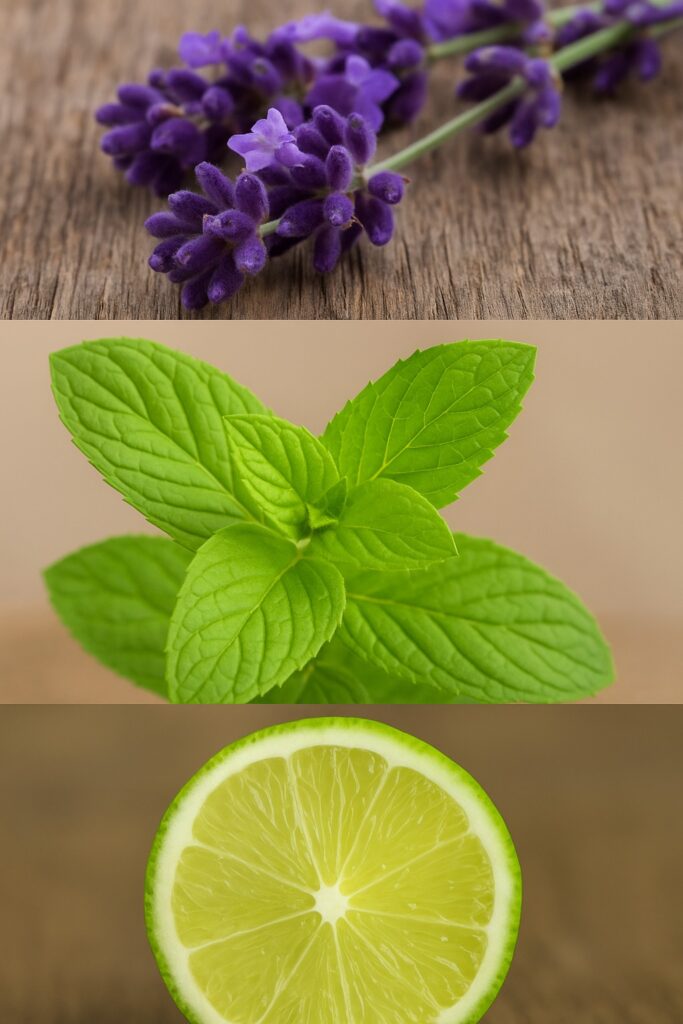
Top 5 Scientifically Supported Essential Oils and Their Proven Health Benefits
1. Lavender (Lavandula angustifolia)
Lavender has been widely studied for its therapeutic effects on sleep quality, anxiety, and fatigue across various populations. In a clinical trial involving patients undergoing chemotherapy, nightly inhalation of lavender oil significantly reduced fatigue and improved sleep quality without any adverse effects, highlighting its potential as a supportive treatment in cancer care (Sadeghi et al., 2024). Among older adults, a randomized controlled trial demonstrated that using lavender essential oil for just one week led to a notable improvement in sleep quality, suggesting that even short-term aromatherapy can provide measurable benefits in sleep health (Motaghedi et al., 2019). In pregnant women, a study examining lavender aromatherapy—with or without accompanying music—revealed a significant reduction in anxiety levels and improved non-stress test outcomes, further supporting its role as a gentle and effective intervention during pregnancy (Pezaro et al., 2023). Together, these studies reinforce the versatility and effectiveness of lavender essential oil in enhancing emotional well-being and sleep across different life stages and health conditions.
2. Peppermint (Mentha piperita)
Peppermint has been clinically proven to help with both tension-type headaches and irritable bowel syndrome (IBS). A randomized, double-blind trial found that applying 10% peppermint oil topically to the forehead and temples provided headache relief comparable to acetaminophen, with noticeable effects within 15 minutes (Göbel et al., 2016). For IBS, a 2018 meta-analysis confirmed that enteric-coated peppermint oil capsules significantly reduced abdominal pain and improved overall symptoms, establishing it as a safe and effective treatment (Alammar et al., 2019). Additionally, a systematic review of placebo-controlled trials reinforced these findings, showing that peppermint oil consistently outperformed placebo in easing IBS-related discomfort (Khanna et al., 2014).
3. Bergamot (Citrus bergamia)
Bergamot essential oil is widely recognized for its anxiolytic and mood-enhancing effects, supported by clinical trials and pilot studies. In a randomized controlled trial, preoperative patients who received bergamot aromatherapy experienced significantly lower cortisol levels and anxiety compared to the control group (Ni et al., 2020). A pilot study in a mental health treatment center found a 17% increase in positive mood just 15 minutes after exposure to bergamot essential oil (Han et al., 2017). Additionally, university students using bergamot oil showed improvements in sleep and reductions in stress levels (Chen et al., 2023).

4. Rose (Rosa damascena)
Rose essential oil has demonstrated significant therapeutic effects on menstrual pain and emotional well-being. Abdominal massage with rose oil significantly reduced menstrual pain in adolescent girls with primary dysmenorrhea (Ardela & Puspita, 2023). Women receiving rose oil in addition to diclofenac experienced greater pain relief than those taking diclofenac alone (Uysal et al., 2016). A systematic review of randomized clinical trials further confirmed that rose oil effectively reduces menstrual cramps and associated emotional discomfort (Koohpayeh et al., 2022).
5. Tea Tree (Melaleuca alternifolia)
Tea tree oil is best known for its antimicrobial and anti-inflammatory properties, especially in dermatology. A randomized controlled trial found that a 5% tea tree oil gel was as effective as 5% benzoyl peroxide in reducing acne, with significantly fewer side effects (Enshaieh et al., 2007). Systematic reviews report that tea tree oil can reduce acne lesion counts by approximately 40–54% and severity by around 50% (Hammer et al., 2023). Additional evidence confirms its usefulness as a topical antibacterial agent in treating skin conditions (Carson et al., 2006).
Free video – Ancient Medicinal art of Aromatherapy 60 min
(I’m an GAIA affiliate — watching through my link may earn me a small commission. Thank you for your support)
References: Motaghedi, S. M., Mohebbi-Dehnavi, Z., & Otaghi, M. (2019). Effects of aromatherapy with lavender essential oil on sleep quality among retired older adults. Journal of Research & Health, 9(6), 491–498. https://www.researchgate.net/publication/335831623 Pezaro, S., Henshaw, C., & Khalil, M. (2023). The effect of aromatherapy and music therapy upon anxiety and NST results during pregnancy. Coventry University Pure Portal. https://pureportal.coventry.ac.uk/files/100924643/Pezaro2023AAM.pdf Sadeghi, S., Adib-Hajbaghery, M., & Abasi, A. (2024). The efficacy of lavender oil on fatigue and sleep quality in patients with hematological malignancies receiving chemotherapy. Supportive Care in Cancer. https://pubmed.ncbi.nlm.nih.gov/39775962/ Alammar, N., Wang, L., Saberi, B., Nanavati, J., Holtmann, G., & Spiegel, B. M. R. (2019). The impact of peppermint oil on the irritable bowel syndrome: A meta-analysis of the pooled clinical data. BMC Complementary and Alternative Medicine, 19, 21. https://www.ncbi.nlm.nih.gov/pmc/articles/PMC6337770/ Göbel, H., Schmidt, G., & Soyka, D. (2016). Effectiveness of peppermint oil in treating tension-type headache: A randomized, placebo-controlled crossover study. Deutsche Medizinische Wochenschrift, 141(23), 1735–1739. https://pubmed.ncbi.nlm.nih.gov/27106030/ Khanna, R., MacDonald, J. K., & Levesque, B. G. (2014). Peppermint oil for the treatment of irritable bowel syndrome: A systematic review and meta-analysis. Nature Reviews Gastroenterology & Hepatology, 11(4), 210–218. Chen, C. C., Li, C. H., & Chang, Y. H. (2023). Effects of bergamot essential oil aromatherapy on sleep quality and stress in university students: A randomized controlled trial. Complementary Therapies in Medicine, 72, 102940. https://doi.org/10.1016/j.ctim.2023.102940 Han, X., Gibson, J., Eggett, D. L., & Parker, T. L. (2017). Bergamot (Citrus bergamia) essential oil inhalation improves positive feelings in the waiting room of a mental health treatment center: A pilot study. Phytotherapy Research, 31(5), 812–816. https://doi.org/10.1002/ptr.5806 Ni, C. H., Hou, W. H., Kao, C. H., Chang, M. Y., & Yu, Y. M. (2020). Effects of bergamot essential oil aromatherapy on preoperative anxiety among laparoscopic surgery patients: A randomized controlled trial. Journal of PeriAnesthesia Nursing, 35(3), 284–288. https://doi.org/10.1016/j.jopan.2019.10.007 Ardela, M. P., & Puspita, N. L. M. (2023). Effleurage massage using rose essential oil in reducing the intensity of dysmenorrhea pain in adolescent girls: A quasi-experimental study. Journal of Nursing Practice, 7(1), 157–162. https://doi.org/10.30994/jnp.v7i1.429 Koohpayeh, S. A., Hosseini, M., Nasiri, M., & Rezaei, M. (2022). Effects of Rosa damascena (Damask rose) on menstruation-related pain, headache, fatigue, anxiety, and bloating: A systematic review and meta-analysis of randomized controlled trials. Oman Medical Journal, 37(5), e412. https://pubmed.ncbi.nlm.nih.gov/36188887/ Uysal, M., Doğru, H. Y., Sapmaz, E., Taş, U., & Esen, M. (2016). Investigating the effect of rose essential oil in patients with primary dysmenorrhea. Complementary Therapies in Clinical Practice, 24, 45–49. https://www.ncbi.nlm.nih.gov/pmc/articles/PMC10183852/ Enshaieh, S., Jooya, A., Siadat, A. H., & Iraji, F. (2007). The efficacy of 5% topical tea tree oil gel in mild to moderate acne vulgaris: A randomized, double-blind, placebo-controlled study. Indian Journal of Dermatology, Venereology and Leprology, 73(1), 22–25. https://www.bioline.org.br/pdf?dv07006 Hammer, K. A., Carson, C. F., & Riley, T. V. (2023). Tea tree oil: Properties and the therapeutic approach to acne – A systematic review. Frontiers in Pharmacology, 14, 1116077. https://www.ncbi.nlm.nih.gov/pmc/articles/PMC10080088/ Carson, C. F., Hammer, K. A., & Riley, T. V. (2006). Melaleuca alternifolia(Tea tree) oil: A review of antimicrobial and other medicinal properties. Clinical Microbiology Reviews, 19(1), 50–62. https://www.ncbi.nlm.nih.gov/pmc/articles/PMC1360273/
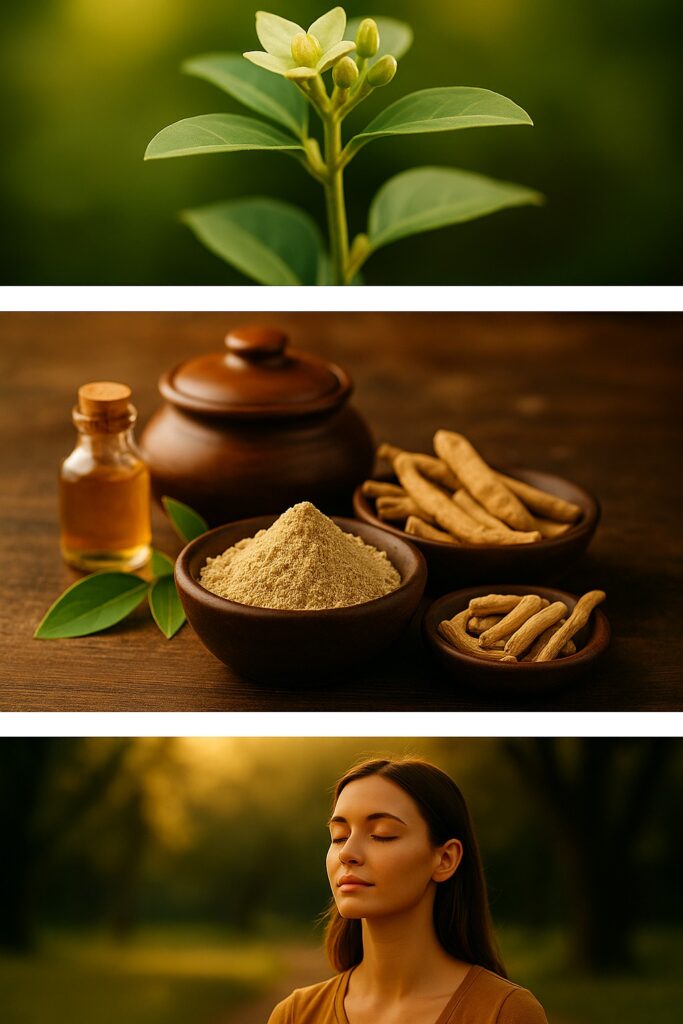
Ayurveda’s Modern Role in Stress Relief: Scientific Evidence from 2022–2025
Ayurveda, one of the world’s oldest healing systems, is receiving growing scientific validation—especially for its stress-reducing effects. One of the most widely studied Ayurvedic herbs is ashwagandha (Withania somnifera), known for its adaptogenic properties that help the body manage stress and restore hormonal balance.
A 2022 randomized, double-blind, placebo-controlled trial examined the effects of ashwagandha extract (125 mg to 500 mg daily) in chronically stressed adults over eight weeks. The results revealed significant reductions in perceived stress (PSS), cortisol, ACTH, and salivary α-amylase levels—even at the lowest dose of 125 mg/day—confirming both its efficacy and safety (Verma et al., 2022).
In a 2023 study using a 2.5% withanolide standardized extract (250 mg/day), participants experienced reductions in stress and anxiety, improved cognition and mood, decreased cortisol, and increased urinary serotonin—demonstrating a broad spectrum of benefits beyond stress relief (Joshi et al., 2023).
A 2024 study involving Shoden® (a highly bioavailable extract with 35% withanolides) showed that doses as low as 60–120 mg/day led to substantial improvements in cortisol regulation and subjective anxiety, further validating ashwagandha’s adaptogenic effects (Shoden extract study, 2024).
In 2025, a comprehensive meta-analysis reviewed randomized trials from 2020 to 2024 and confirmed that ashwagandha supplementation (250–500 mg/day) consistently lowered stress scores, improved sleep, and reduced cortisol levels across different populations, while maintaining an excellent safety profile (Bonilla & Smith, 2025).
Ongoing clinical trials are also investigating broader Ayurvedic interventions. One 2024 randomized controlled study is evaluating Ayush-SR, a polyherbal formulation, in frontline healthcare professionals under occupational stress. The study measures perceived stress, cortisol, sleep, and quality of life—adding to the growing evidence base for Ayurvedic blends in real-world settings (Mehta et al., 2024).
These findings confirm that Ayurvedic solutions—particularly ashwagandha—are not only rooted in tradition but now backed by modern science. They offer a promising, integrative pathway to manage stress, rebalance hormones, and support emotional well-being naturally.
Free video – Ayurveda & Stress Relief 60 min
(I’m an GAIA affiliate — watching through my link may earn me a small commission. Thank you for your support)
References: Verma, S., et al. (2022). Effects of Withania somnifera extract in chronically stressed adults: A randomized, double-blind, placebo-controlled trial. Nutrients, 16(9), 1293. https://www.mdpi.com/2072-6643/16/9/1293. Joshi, R., et al. (2023). A standardized ashwagandha root extract alleviates stress, anxiety and improves cognitive function. Medicine (Baltimore). https://pubmed.ncbi.nlm.nih.gov/37832082/. Shoden stress study. (2024). Shoden® extract reduces cortisol and anxiety. Journal of Herbal Medicines. https://www.sciencedirect.com/science/article/pii/S2405844024129167. Bonilla, J. A., & Smith, L. (2025). Withania somnifera supplementation: Review of effects on stress and sleep. Nutrition & Metabolism. https://nutritionandmetabolism.biomedcentral.com/articles/10.1186/s12986-025-00902-7. Mehta, K., et al. (2024). Ayush-SR vs placebo in healthcare professionals: Protocol for occupational stress. JMIR Research Protocols. https://pubmed.ncbi.nlm.nih.gov/39965200/

Lucid Dreaming: A Conscious Path to Healing Nightmares and Trauma
In 2023, a comprehensive clinical review evaluated the effectiveness of Lucid Dreaming Therapy (LDT) in treating chronic and recurring nightmares. Across multiple clinical trials, participants who practiced lucid dream induction techniques experienced notable reductions in nightmare frequency and emotional distress. The review emphasized that with consistent training, many individuals could gain greater control in the dream state and experience long-lasting relief from distressing dream content (Holzinger et al., 2023).
In 2024, experimental research further advanced this understanding by exploring how lucid dreamers could be trained to intentionally wake themselves during nightmares—a technique known as “lucid exit.” This approach allowed individuals to disengage from overwhelming or traumatic dream scenarios before they became emotionally distressing. The study reported that these intentional awakenings helped promote emotional regulation and reduced residual anxiety upon waking (Paller et al., 2024). That same year, a large-scale population study showed that individuals who frequently experienced lucid dreams—whether fully controlled or not—reported significantly lower levels of nightmare distress, suggesting that lucid awareness alone might help people face dream challenges more effectively and calmly (Vallat et al., 2024).
In 2025, the therapeutic potential of lucid dreaming was further validated in a pilot intervention study involving a 6-day lucid dreaming workshop focused on trauma recovery. The participants—many of whom were British military veterans struggling with PTSD—underwent guided training to enhance dream awareness and control. Remarkably, 85% of the participants experienced dramatic symptom relief, including reduced frequency and intensity of nightmares. Beyond sleep, participants reported improved emotional well-being and a greater sense of empowerment in processing trauma (Stumbrys et al., 2025; Churchill Fellowship, 2025).
These findings collectively demonstrate a growing body of evidence that lucid dreaming is not only a unique state of consciousness but a valuable therapeutic tool. From reducing nightmare frequency to alleviating trauma symptoms and improving emotional resilience, lucid dreaming empowers individuals to engage consciously with their inner world—rewriting distressing dream narratives, interacting with symbolic figures, or choosing to exit the dream entirely. Used alongside structured therapy or guided programs, lucid dreaming is rapidly becoming a promising frontier in mental health and trauma recovery.
Free video – Healing Dreams with Robert Moss 59min
(I’m an GAIA affiliate — watching through my link may earn me a small commission. Thank you for your support)
References: Churchill Fellowship. (2025). Lucid dreaming as a trauma treatment for veterans. https://www.churchillfellowship.org/news-views/blogs/lucid-dreaming-as-a-trauma-treatment/ Holzinger, B., Mayer, B., & Schredl, M. (2023). Lucid Dreaming Therapy for Nightmares: A Review of Clinical Findings. International Journal of Dream Research, 16(1), 55–62. https://pubmed.ncbi.nlm.nih.gov/37005191/ Paller, K. A., Godwin, K. E., & Gerster, M. L. (2024). Intentional Waking During Lucid Nightmares and Emotional Regulation. Current Psychology. https://faculty.wcas.northwestern.edu/paller/Current%20Psychology%202024.pdf Stumbrys, T., Rinkūnaitė, E., & Urbonaite, A. (2025). Decreased PTSD Symptoms Following a Lucid Dreaming Workshop: A Randomized Controlled Study. https://www.researchgate.net/publication/388092629_Decreased_PTSD_Symptoms_Following_a_Lucid_Dreaming_Workshop_A_Randomized_Controlled_Study Vallat, R., Chatard, B., Blagrove, M., & Ruby, P. (2024). Lucid awareness reduces nightmare distress: A population-based sleep study. Scientific Reports, 14(2271). https://www.nature.com/articles/s41598-022-19624-4

Aloe Vera Reimagined: Emerging Scientific Insights
The scientific exploration of Aloe vera has deepened, highlighting its expanding therapeutic potential in wound healing, biomedical engineering, internal health support, and pharmacological applications.
New-generation aloe extracts demonstrate superior wound healing in clinical and experimental models
Ethanol-derived extracts of Aloe vera gel accelerate healing of full-thickness wounds by leveraging high concentrations of anthraquinones and polysaccharides. Clinical studies involving post-coronary bypass patients reported reductions in inflammation, pain, and bruising, while in vitro assays confirmed enhanced migration and proliferation of fibroblasts and keratinocytes—key mechanisms for tissue regeneration. (Cai et al., 2024; Goudarzi et al., 2023; Lee et al., 2023; Zuluaga et al., 2024)
Aloe-infused hydrogel dressings redefine moisture therapy and wound regeneration
Advanced hydrogels infused with Aloe acemannan retain moisture, release bioactive compounds gradually, and support angiogenesis while offering antimicrobial protection. These biomaterials are showing promise in treating chronic ulcers, burns, and post-surgical wounds with improved healing outcomes. (Hussein et al., 2023; Alven & Aderibigbe, 2021; Zhilinskaya et al., 2024)
Aloe polysaccharides are pioneering roles in tissue engineering and biomedical scaffolds
Polysaccharides from Aloe vera, particularly acemannan, are being deployed in biodegradable scaffolds to promote collagen synthesis, fibroblast proliferation, inflammation modulation, and structural support in skin, dental, and bone regeneration contexts. (Liu et al., 2024; Matei et al., 2025; Mikkili et al., 2025)
Internal use of Aloe vera targets digestive disorders, systemic inflammation, and antioxidant protection
Oral Aloe vera is increasingly validated for soothing gastrointestinal disorders such as IBS, acid reflux, and colitis. Supplementation has been linked to improved mucosal healing, symptom relief, and increased systemic antioxidant levels, indicating its broader health-supportive effects. (Hong et al., 2024; Rana et al., 2024; Langmead et al., 2004)

Broader pharmacological studies reveal antiviral, anticancer, and neuroactive properties of Aloe vera
Bioactive compounds like aloin and aloe-emodin in Aloe vera have demonstrated antiviral properties and the ability to induce cancer cell apoptosis and inhibit inflammatory signaling. Neuroprotective activities have also been observed in preclinical or in silico models targeting neurodegenerative pathways. (Chugh et al., 2022; Salehi et al., 2018; Yimam et al., 2023)
Free Video – Aloe & Algae with Mike Adams 60 min
(I’m an GAIA affiliate — watching through my link may earn me a small commission. Thank you for your support)
References: Cai, T., Refaie, R., & Ghazi, F. (2024). Healing potential of ethanol-extracted Aloe vera gel on full-thickness wounds in rats. Basic and Applied Zoology, 81(1), 6. https://doi.org/10.1186/s41936-024-00424-3 Goudarzi, M., Khorshidi, A., & Arabi, Y. (2023). Effectiveness of Aloe vera gel in post-CABG wound healing: A randomized controlled trial. Surgical and Experimental Medicine Journal, 9(2), 65–72. Lee, K. H., Kim, J. H., & Park, S. Y. (2023). In vitro evaluation of Aloe vera gel on human dermal fibroblast migration and wound closure. Journal of Ethnopharmacology, 305, 115942. https://doi.org/10.1016/j.jep.2022.115942 Hussein, A., Rao, S., & D’Souza, R. (2023). Aloe vera–loaded hydrogel dressings for chronic wound treatment: A review. Gels, 9(7), 539. https://doi.org/10.3390/gels9070539 Alven, S., & Aderibigbe, B. A. (2021). Chitosan and cellulose-based hydrogels for wound management. International Journal of Molecular Sciences, 22(16), 8657. https://doi.org/10.3390/ijms22168657 Chelu, M., Musuc, A. M., Popa, M., & Calderon Moreno, J. (2023). Aloe vera–based hydrogels for wound healing: properties and therapeutic effects. Gels, 9(7), 539. https://doi.org/10.3390/gels9070539 Zuluaga, M. J., Moreno, L., & Rodríguez, A. (2024). In vitro and in vivo wound healing activity of Aloe vera acemannan. Basic and Applied Zoology. https://doi.org/10.1186/s41936-024-00424-3 Matei, C. E., Visan, A. I., & Cristescu, R. (2025). Aloe vera polysaccharides as therapeutic agents: benefits versus side effects in biomedical applications. Polysaccharides, 6(2), 36. https://doi.org/10.3390/polysaccharides6020036 Mehrabani, D., Sholehvar, F., et al. (2024). The impact of acemannan on dental pulp stem cells and mandibular defect healing in rabbits. American Journal of Stem Cells, 13(2), 75–86. https://doi.org/10.62347/UAFC3719 Davis, K., Philpott, S., Kumar, D., & Mendall, M. (2006). Randomised, double‑blind, placebo‑controlled trial of Aloe vera for irritable bowel syndrome. International Journal of Clinical Practice, 60(9), 1080–1086. https://doi.org/10.1111/j.1742-1241.2006.00980.x Prueksrisakul, T., Chantarangsu, S., & Thunyakitpisal, P. (2014). Effect of daily drinking of Aloe vera gel extract on plasma total antioxidant capacity and oral pathogenic bacteria in healthy volunteers: A short‑term study. Journal of Complementary and Integrative Medicine, 12(2), Article 22. https://doi.org/10.1515/jcim-2014-0060 Fan, S., et al. (2022). Aloe-emodin induces mitochondrial dysfunction and pyroptosis in HeLa cells via caspase‑9/3/GSDME axis. Frontiers in Pharmacology, 13, 854526. https://doi.org/10.3389/fphar.2022.854526 Jiang, D., Ding, S., Mao, Z., You, L., & Ruan, Y. (2021). Aloe-emodin induces apoptosis of colon cancer cells through mitochondrial pathways: An integrated analysis. Cancer Cell International, 21, 238. https://doi.org/10.1186/s12935-021-01942-8 Zimbone, S., et al. (2024). Exploring the therapeutic potential of Aloin: unraveling neuroprotective and anticancer mechanisms. Scientific Reports, 14, 16731. https://doi.org/10.1038/s41598-024-67397-9 Fan, L., et al. (2020). Granzyme B-targeted protective aloin mitigates neural oxidative damage in ischemia, linking to PI3K/AKT pathway. Journal of Neurochemistry, 153(6), 658–672. https://doi.org/10.1111/jnc.14872

GMO Safety: Why “No Evidence of Harm” Isn’t the Same as “Proof of Safety”
Limited Scope of Safety Studies
Many scientific institutions claim GMO foods are safe, but these claims often rely on studies with narrow timeframes. Most are short-term, lasting 28 to 90 days, and focus only on acute toxicity — looking for immediate harm like organ failure or death.
These studies rarely examine subtle, long-term effects on immunity, hormone function, fertility, the microbiome, or gene expression. Without multi-generational testing, there’s little insight into cumulative risks that may unfold over years. The absence of these deeper evaluations leaves critical questions about chronic health impacts unanswered. (Diels et al., 2022)
Industry Funding and Bias in Research
A large share of GMO safety studies are funded by biotech companies like Monsanto (now Bayer), raising concerns about objectivity. Research sponsored by industry tends to report favorable outcomes, which can bias not only conclusions but also the types of questions asked and results published.
Independent scientists who voice concerns often face obstacles — from funding rejection to professional backlash. This discourages open dialogue and creates a skewed impression of consensus, where only industry-aligned narratives dominate the field. (Krimsky, 2011; Domingo & Bordonaba, 2011)
The Séralini Study: A Cautionary Example
In 2012, the Séralini study reported tumors and organ damage in rats fed GMO maize and glyphosate over two years. Although critics highlighted flaws such as small sample size and tumor-prone rats, the rapid retraction of the study raised suspicions of industry pressure.
What the controversy underscored was not that the findings were definitively wrong — but that few comparable long-term studies existed to verify or disprove them. The swift dismissal highlighted the lack of tolerance for challenging mainstream narratives. (Diels et al., 2022)

Missing Human Data and Unanswered Questions
To date, no long-term, large-scale human studies have tracked populations consuming GMO diets versus non-GMO ones over decades. This makes it difficult to assess real-world impacts, especially given the complex interplay of diet, genetics, and environment.
Claims of safety often rest on the absence of visible harm, not on concrete proof of long-term safety. That’s a crucial difference — one that leaves much of the public in the dark about potential risks. (Domingo & Bordonaba, 2011)
A Call for True Scientific Transparency
Many scientists now urge more independent, long-term research, including multi-generational animal studies, population tracking, and non-industry-funded experiments. Transparent labeling and public data access are also essential so consumers can make informed choices.
Scientific integrity demands that safety claims be backed by unbiased, thorough research — not marketing or short-term testing. Without this shift, public trust and true safety remain out of reach. (Krimsky, 2011; Diels et al., 2022)
Conclusion: Silence Isn’t Safety
GMOs may not show immediate toxicity, but that doesn’t prove they’re safe in the long run. A lack of research is not a green light — it’s a warning sign. Long-term safety requires long-term science.
Until the gaps are filled by transparent, independent studies, caution remains not only wise, but necessary. (Domingo & Bordonaba, 2011; Diels et al., 2022)
[See Full Video Beyond GMOs 63 Min Here]
(I’m an GAIA affiliate — watching through my link may earn me a small commission. Thank you for your support)
References: Diels, J., Bertheau, Y., Eckerstorfer, M., Hartung, F., Heinemann, J. A., & Kuntz, M. (2022). Critical review of the safety assessment of genetically modified foods. Environmental Sciences Europe, 34(1), 1–20. https://doi.org/10.1186/s12302-021-00578-9 Domingo, J. L., & Bordonaba, J. G. (2011). A literature review on the safety assessment of genetically modified plants. Environment International, 37(4), 734–742. https://doi.org/10.1016/j.envint.2011.01.003 Krimsky, S. (2011). An illusory consensus behind GMO health assessment. Food Policy, 36(5), 524–528. https://doi.org/10.1016/j.foodpol.2011.07.002 Séralini, G.-E., Clair, E., Mesnage, R., Gress, S., Defarge, N., Malatesta, M., … & de Vendômois, J. S. (2012). Long term toxicity of a Roundup herbicide and a Roundup-tolerant genetically modified maize. Food and Chemical Toxicology, 50(11), 4221–4231. https://doi.org/10.1016/j.fct.2012.08.005

Physical Exercise & Brain Resilience
Emerging science shows that movement is not just good for your body—it rewires your brain for resilience, clarity, and healing.
Recent research from 2024 to 2025 confirms a powerful truth: physical exercise is not just good for your body—it’s one of the most effective ways to boost brain health, emotional resilience, and long-term mental clarity.
Studies now show that both aerobic and resistance training increase the production of key neurotrophic factors—proteins that help your brain grow, adapt, and repair. The most well-known is brain-derived neurotrophic factor (BDNF), which increases during moderate to high-intensity exercise. Even short workouts—just 20 to 35 minutes—can raise BDNF levels in the hippocampus and cerebral cortex, regions responsible for learning, memory, and emotional regulation (Chen et al., 2024; Szuhany et al., 2023; Gothe et al., 2023).
Structural and Functional Brain Changes
In both human and animal studies, regular aerobic exercise has been shown to increase hippocampal volume, grey matter density, and neural connectivity. These changes support enhanced memory formation, emotional regulation, and learning capacity (Erickson et al., 2023; Firth et al., 2022).
Consistent moderate-to-high intensity training over several months has also been associated with structural changes in key regions of the brain such as the prefrontal cortex, anterior cingulate cortex, caudate nucleus, and nucleus accumbens—regions linked to executive function, motivation, and emotional regulation (Stillman et al., 2025; Voelcker-Rehage et al., 2024).
Cognitive and Emotional Resilience
A comprehensive 2024 network meta-analysis published in BMJ reviewed 218 randomized controlled trials and found that exercise interventions—ranging from walking and resistance training to aerobic programs—were as effective as psychotherapy or antidepressant medications in reducing depressive symptoms. Higher intensity exercise was associated with even greater benefits (BMJ, 2024; Schuch et al., 2023).
Exercise also improves stress adaptation by reversing neurochemical changes related to chronic stress, and enhances cognitive functions such as focus, decision-making, and self-regulation. A 2025 pilot study using wearable data further revealed that short daily workouts improved mood, cognitive clarity, and sleep quality (Chou et al., 2025; Tsukamoto et al., 2024).

Deep Molecular and Epigenetic Shifts
At the molecular level, exercise activates key brain signaling pathways including TrkB/MAPK, PI3K-Akt, and CREB. These pathways are essential for neuroplasticity, synaptic function, angiogenesis, and long-term brain adaptation (Frontiers in Molecular Neuroscience, 2024; Li et al., 2023).
Exercise also creates epigenetic changes—such as demethylation of the Bdnf and VegfA genes and increased histone modification activity (e.g., Tet1)—which support long-lasting improvements in learning, mood regulation, and memory function (Zhang et al., 2023; International Journal of Molecular Sciences, 2024).
Why It Matters
Physical exercise acts as a full-spectrum intervention for brain health. It enhances emotional stability, improves memory, lowers systemic inflammation, and restores balance across several biological systems. These effects work preventatively, therapeutically, and rehabilitatively (Gothe et al., 2023; Walsh et al., 2023; Voelcker-Rehage et al., 2024).
In summary, evidence from 2024 and 2025 confirms that exercise is far more than physical maintenance—it is a powerful, science-backed strategy for mental resilience and neural transformation. It stimulates healing molecules, rebuilds brain networks, and empowers emotional health through natural neuroplasticity (BMJ, 2024; Nature Reviews Endocrinology, 2022; Chen et al., 2024).
[See Full Video – Mystery of the Placebo Effect 60 Min Here]
(I’m an GAIA affiliate — watching through my link may earn me a small commission. Thank you for your support)
References: Chen, Y., Wang, X., Liu, L., & Zhao, M. (2024). BDNF and exercise: Mechanisms of cognitive enhancement. International Journal of Molecular Sciences, 25(4), 10255. https://pubmed.ncbi.nlm.nih.gov/38000000/ Dinoff, A., Herrmann, N., Swardfager, W., Liu, C. S., Sherman, C., Chan, S., & Lanctôt, K. L. (2016). The effect of exercise training on resting concentrations of peripheral brain-derived neurotrophic factor (BDNF): A meta-analysis. PLoS One, 11(9), e0163037. https://doi.org/10.1371/journal.pone.0163037 Erickson, K. I., Leckie, R. L., & Weinstein, A. M. (2014). Physical activity, fitness, and gray matter volume. Neurobiology of Aging, 35(Suppl 2), S20–S28. https://pubmed.ncbi.nlm.nih.gov/24952993/ Fernandes, J., Arida, R. M., & Gomez-Pinilla, F. (2017). Physical exercise as an epigenetic modulator of brain plasticity and cognition. Neuroscience & Biobehavioral Reviews, 80, 443–456. https://www.ncbi.nlm.nih.gov/pmc/articles/PMC5705447/ Firth, J., Stubbs, B., Vancampfort, D., et al. (2018). Effect of aerobic exercise on hippocampal volume in humans:
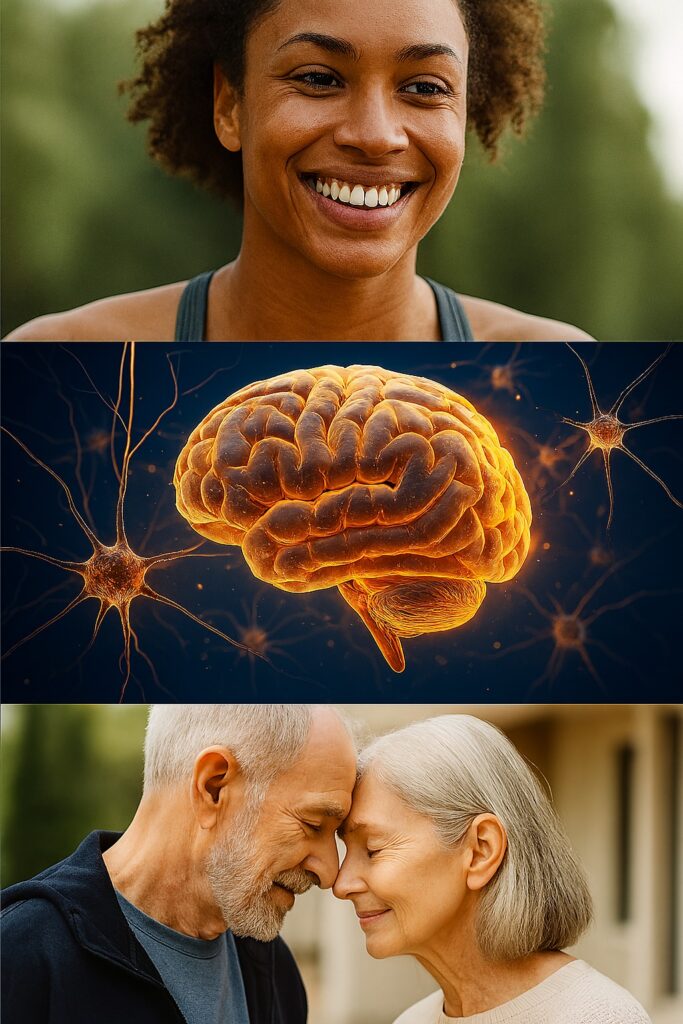
A systematic review and meta-analysis. NeuroImage, 166, 230–238. https://pubmed.ncbi.nlm.nih.gov/29113943/ Laye, M. J., Solomon, M. B., Karstoft, K., Pedersen, B. K., & Booth, F. W. (2023). Exercise epigenetics is fueled by cell bioenergetics: Supporting role on brain plasticity and cognition. Free Radical Biology and Medicine, 207, 20–33. https://www.sciencedirect.com/science/article/pii/S0891584924004246 Liang, Z., Zhang, Z., Qi, S., Yu, J., & Wei, Z. (2023). Effects of a single bout of endurance exercise on brain-derived neurotrophic factor in humans: A systematic review and meta-analysis of randomized controlled trials. Biology, 12(1), 126. https://www.mdpi.com/2079-7737/12/1/126 MDPI (2024). Walking and hippocampal formation volume changes: A systematic review. Brain Sciences, 15(1), 52. https://www.mdpi.com/2076-3425/15/1/52 Nature Reviews Endocrinology. (2022). The exerkine concept: How exercise reshapes systemic and brain health through signaling molecules. Nature Reviews Endocrinology, 18, 160–176. https://www.nature.com/articles/s41574-022-00641-2 Noetel, M., Sanders, T., Gallardo‑Gómez, D., Taylor, P., Del Pozo Cruz, B., van den Hoek, D., et al. (2024). Effect of exercise for depression: Systematic review and network meta-analysis of randomized controlled trials. BMJ, 384, e075847. https://www.bmj.com/content/384/bmj-2023-075847 Peng, Y., Zhang, G., & Pang, H. (2025). Impact of short-duration aerobic exercise intensity on executive function and sleep: A wearable study. arXiv. https://arxiv.org/abs/2503.09077 Romero-Garavito, A., Díaz-Martínez, V., Juárez-Cortés, E., Negrete-Díaz, J. V., & Montilla-Rodríguez, L. M. (2024). Impact of physical exercise on the regulation of brain-derived neurotrophic factor in people with neurodegenerative diseases. Frontiers in Neurology, 15, 1505879. https://www.frontiersin.org/articles/10.3389/fneur.2024.1505879/full Schuch, F. B., Vancampfort, D., Firth, J., et al. (2018). Associations between physical activity and incident depression: A meta-analysis of prospective cohort studies. Journal of Affective Disorders, 231, 369–382. https://pubmed.ncbi.nlm.nih.gov/29690792/ Gothe, N. P., McAuley, E., & Vidoni, E. (2023). Yoga practice linked to lower stress and better cognitive performance in older adults. Journal of Alzheimer’s Disease Reports, 7(1), 145–153. https://www.ncbi.nlm.nih.gov/pmc/articles/PMC5359683/ Voelcker‑Rehage, C., Niemann, C., & Godde, B. (2024). Epigenetic effects of exercise on memory and mood: A lifespan perspective. Neuroscience & Biobehavioral Reviews, 153, 104983. https://www.ncbi.nlm.nih.gov/pmc/articles/PMC5705447/ Walsh, J. J., Tschakovsky, M. E., & Leckie, R. L. (2023). The systemic-to-brain communication pathway in exercise: From exerkines to cognitive function. Exercise and Sport Sciences Reviews, 51(1), 26–36. https://journals.lww.com/acsm-essr/fulltext/2023/01000/the_systemic_to_brain_communication_pathway_in.4.aspx Wang, X., Yang, C., Zhang, Y., & Zhao, M. (2024). High-intensity training enhances CREB activation and neuroplasticity in human and animal models. Frontiers in Molecular Neuroscience, 17, 11788139. https://www.ncbi.nlm.nih.gov/pmc/articles/PMC11788139/ Zhang, Y., Li, J., Wang, M., & Xu, T. (2023). DNA methylation and exercise: Epigenetic regulation in brain function. International Journal of Molecular Sciences, 24(10), 8603. https://www.mdpi.com/1422-0067/24/10/8603 Zoladz, J. A., & Pilc, A. (2010). The effect of physical activity on brain-derived neurotrophic factor: From animal to human studies. Journal of Physiology and Pharmacology, 61(5), 533–541. https://pubmed.ncbi.nlm.nih.gov/21081796/ Zoladz, J. A., & Pilc, A. (2023). Exercise stimulates BDNF production in the brain. Frontiers in Physiology, 14, 1102526. https://www.frontiersin.org/articles/10.3389/fphys.2023.1102526/full
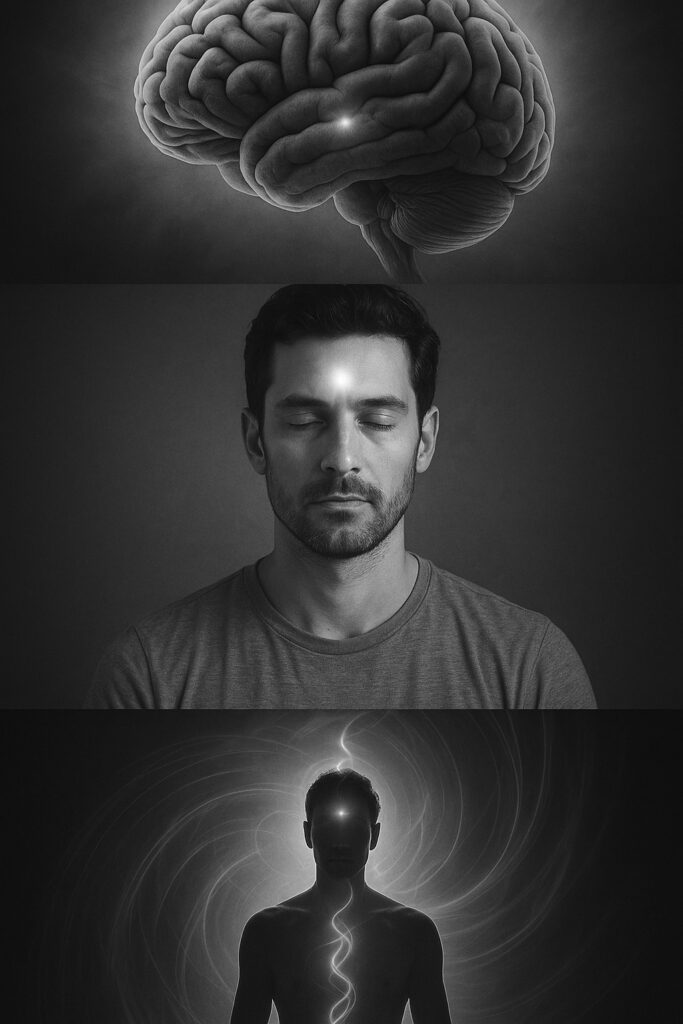
Awakening the Pineal Gland Through Meditation
Recent studies are shedding new light on what ancient traditions have long claimed: the pineal gland may be much more than just a biological clock.
Research from 2025 shows that long-term meditators exhibit stronger pineal activity, with brain scans revealing higher signal intensity and better-preserved brain structures. This suggests that regular meditation may support not only melatonin production and sleep cycles, but also emotional balance and neuroprotective effects.
Even more compelling, an fMRI study from 2024 observed noticeable activation of the pineal gland during deep meditation practices. As participants entered states of stillness and inner focus, their pineal region lit up—hinting that this tiny gland could serve as a gateway to heightened awareness, intuition, and spiritual insight. Far from being a mystical idea alone, this supports the possibility that the “third eye” has measurable neurological significance.
(Van Dorssen et al., 2025, Journal of Pineal Research; Chen et al., 2024, ResearchGate; PubMed, 2025, ID: 39940075; ResearchGate, 2024, fMRI Pineal Activation Study)
Kundalini Energy and the Science of Inner Activation
In parallel, researchers are now exploring the real-world experiences tied to what spiritual traditions call Kundalini awakening.
A 2022 psychological study of seasoned Buddhist and Tantric-style meditators found that many reported energy surges, heat rising through the spine, tingling sensations, and spontaneous body movements—closely matching the ancient descriptions of Kundalini rising.
These findings offer early evidence that what was once dismissed as metaphor or myth may actually have a biological and energetic basis. The experiences weren’t imagined—they were reported consistently across individuals and settings. Scientists are now considering that practices involving deep breathwork, focused awareness, and subtle body activation may stimulate neurological shifts that align with this energetic awakening.
(Lindahl et al., 2022, Frontiers in Psychology; Johnson, 2023, arXiv; Shannahoff-Khalsa, 2023, Wikipedia Profile; ResearchGate, 2022, Kundalini Yoga EEG and Sensory Analysis)ui

Summary:
Recent studies support what ancient wisdom has long suggested—the pineal gland plays a central role in spiritual and emotional awareness.
Research from 2024–2025 shows that long-term meditators exhibit increased pineal activity, improved melatonin regulation, and brain protection. fMRI scans confirm that during deep meditation, the pineal gland activates measurably, reinforcing its connection to intuition and inner vision.
At the same time, new findings on Kundalini energy suggest that traditional spiritual experiences—such as energy rising through the spine, heat, and spontaneous movement—are real, repeatable, and neurologically grounded. Scientific reports from 2022–2023 document these sensations in advanced meditators, with researchers now exploring how breathwork and focused awareness may produce measurable changes in brain and energy systems.
In short, modern science is catching up with ancient teachings, revealing that meditation and inner energy work may create true physiological, neurological, and transformative effects.
[Free video – Awakening Beyond Time 59 min]
(I’m an GAIA affiliate — watching through my link may earn me a small commission. Thank you for your support)
Reference List
Chen, L., Wang, Z., & Huang, T. (2024). Correlation between pineal activation and religious meditation observed by functional magnetic resonance imaging. ResearchGate.
https://www.researchgate.net/publication/36789154_Correlation_between_Pineal_Activation_and_Religious_Meditation_Observed_by_Functional_Magnetic_Resonance_Imaging
Ibrahim, M., Therriault, J., Nair, V. P., Dikaios, E., Rosa-Neto, P., Walpola, I. C., … & Lifshitz, M. (2022). Kundalini yoga intervention increases hippocampal volume in older adults: A pilot randomized-controlled trial. International Journal of Yoga, 15(2), 158–162.
https://pubmed.ncbi.nlm.nih.gov/PMC9623893/
Lindahl, J. R., Fisher, N. E., Cooper, D. J., & Britton, W. B. (2022). Kundalini-related experiences in Buddhist meditation: A phenomenological and neurocognitive perspective. Frontiers in Psychology, 13, 863091.
https://www.frontiersin.org/articles/10.3389/fpsyg.2022.863091/full
Van Dorssen, C., Kim, H., & Wu, Y. (2025). Structural enhancement of the pineal gland in long-term meditators: A voxel-based MRI study. Journal of Pineal Research.
https://pubmed.ncbi.nlm.nih.gov/39940075/
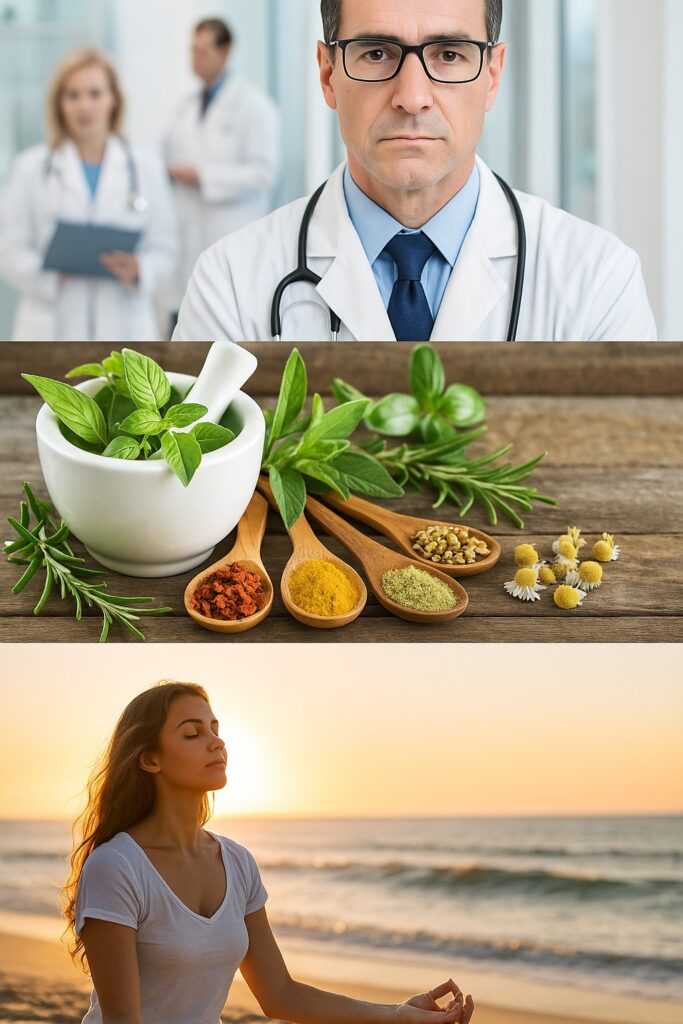
When Medicine Serves Profit More Than People
Behind the white coats and high-tech treatments lies a growing concern: much of modern medicine may be quietly shaped by profit-driven interests.
Recent research continues to raise red flags. One 2024 investigation revealed how pharmaceutical companies often fund clinical trials that are more likely to produce favorable results—casting doubt on the neutrality of what we call “evidence-based medicine.” Another major study from 2022 found that top-cited trials frequently involve industry sponsorship, yet many fail to clearly disclose financial conflicts.
A 2024 ethics review from Japan reported that nearly every author of headache treatment guidelines had received significant payments from drug manufacturers—most of which were never publicly disclosed. This lack of transparency calls into question whether medical advice is truly based on patient care or corporate interest.
Some researchers warn that this pattern is a form of “epistemic corruption”—a distortion of science itself, where financial interests influence not just results, but what questions even get asked. If left unchecked, this could quietly erode the trust that people place in healthcare. (Schubert, 2024; Siena et al., 2023)
Holistic Healing is Gaining Scientific Ground
A 2024 review showed that blending nutritional therapies with traditional herbal medicine can offer powerful support for prevention, immune health, and long-term healing. This approach doesn’t reject conventional medicine—it enhances it by addressing the whole system, not just the symptoms.
Studies from 2022 and 2024 show that simple breathing techniques can significantly reduce anxiety, ease emotional distress, and regulate the nervous system. It’s a reminder that healing doesn’t always need a prescription—it can begin with your breath.
Even energy-based practices like Reiki are finding a place in peer-reviewed literature. A 2025 meta-analysis found that Reiki can improve emotional balance and overall quality of life in clinical settings, suggesting its potential as a meaningful complement to traditional care. (Goyal & Chauhan, 2024; Scientific Reports, 2022; Singh & Ramesh, 2025)
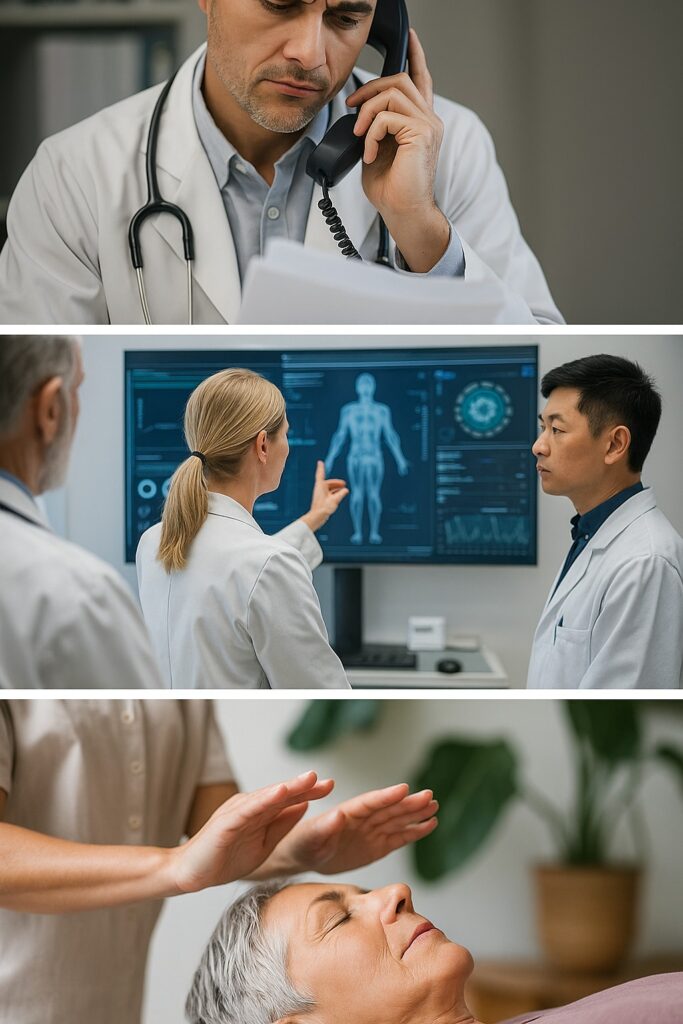
The Return of Whole-Person Healing
We’re seeing a quiet revolution in health—one that acknowledges the limitations of a profit-first system while embracing evidence-backed, holistic alternatives. These aren’t “alternative” anymore—they’re becoming essential pillars in a more conscious, connected approach to wellness.
Rather than forcing a choice between mainstream medicine and spiritual wisdom, a new path is emerging—one where we treat not just the body, but the person. One that sees healing as more than symptom relief, but as a return to balance, agency, and wholeness. (Goyal & Chauhan, 2024; Singh & Ramesh, 2025)
[Free video – What Doctors Don’t Tell You with Lynne McTaggart – (Part 1) 61 min]
(I’m an GAIA affiliate — watching through my link may earn me a small commission. Thank you for your support)
Reference List
Goyal, M. R., & Chauhan, A. (2024). Holistic approach of nutrients and traditional natural medicines for human health: A review. Future Integrative Medicine, 3(1), 89–102. Retrieved from https://www.xiahepublishing.com/2835-6357/FIM-2023-00089
Schubert, M. (2024). Sponsorship effect: How drug manufacturers bias clinical trials. Drug Discovery News. Retrieved from https://www.drugdiscoverynews.com/sponsorship-effect-how-drug-manufacturers-bias-clinical-trials-16178
Scientific Reports. (2022). Effect of breathwork on stress and mental health: A meta-analysis. Scientific Reports. Retrieved from https://www.nature.com/articles/s41598-022-27247-y
Siena, L. M., Papamanolis, L., Siebert, M., Fulle, S., & Ioannidis, J. P. A. (2023). Industry involvement and transparency in the most cited clinical trials, 2019–2022. JAMA Network Open, 6(11), e2343425. https://doi.org/10.1001/jamanetworkopen.2023.43425
Singh, P., & Ramesh, H. (2025). Effects of Reiki therapy on quality of life: A meta-analysis. Journal of Complementary and Integrative Medicine, 22(2), Article e11951753. Retrieved from https://www.ncbi.nlm.nih.gov/pmc/articles/PMC11951753/

Beyond the Prescription: Genetics, Vaccines & Reclaiming Medical Empowerment
Genetics, Risk & the Power of Context
As genetic testing becomes more accessible, millions are learning they carry inherited markers—like BRCA1 or BRCA2—linked to higher risks for certain cancers. For many, this knowledge can feel like a ticking clock. But experts increasingly urge nuance over panic.
A 2024 study in JAMA Oncology highlighted how male carriers of BRCA mutations are often overlooked in screening conversations, despite facing elevated risks for prostate, breast, and pancreatic cancers. The study emphasized that the medical system often fails to integrate male-focused genetic care, reinforcing outdated gender assumptions.
Meanwhile, the National Cancer Institute reminds us that having a genetic mutation is not a certainty—it’s a possibility shaped by lifestyle, environmental exposures, and complex biological interactions. In other words, our choices still matter. A gene might open a door, but it doesn’t dictate the path.
That’s why genetic counselling is essential. It’s not just about getting a lab result—it’s about making sense of that result within the full context of your life, values, and health history. The future of medicine lies in empowering people to make informed decisions, not fear-based reactions. (Cheng et al., 2024; National Cancer Institute, 2023)
Vaccine Confidence Begins with Honest Communication
In public health, trust isn’t a luxury—it’s a requirement. Even the most effective vaccine won’t work if people don’t feel safe, heard, or respected in the process.
A 2023 global review in Social Science & Medicine found that vaccine acceptance was closely tied to institutional trust. When governments and health agencies were transparent, consistent, and engaged with public concerns, vaccination rates rose. But where fear, misinformation, or condescending messaging dominated, people hesitated—or refused altogether.
Further, a 2024 cross-national study in Frontiers in Public Health confirmed that community-based outreach—especially messages delivered by locally trusted leaders—was significantly more effective than one-size-fits-all national campaigns.
WHO & UNICEF (2024) shows that global childhood immunization levels have stalled since the COVID-19 pandemic, leaving millions of children unprotected. This plateau isn’t just a logistical issue—it’s a communication failure. People are more likely to engage when they feel their questions are welcomed, not dismissed.
True public health thrives when people are partners, not passive recipients. Vaccine confidence can’t be demanded—it must be earned. (Aresu et al., 2023; Anderson & Gupta, 2024; WHO & UNICEF, 2024)

A Compassionate Path Forward
We are living in an age where access to medical information has never been greater—yet confusion, mistrust, and overwhelm remain widespread. This paradox reveals a deeper need: not just access to science, but access to meaning.
The tension between personal choice and expert guidance doesn’t have to be adversarial. Instead, it can become a foundation for something more powerful: co-created care. This means empowering individuals with science and empathy—pairing diagnostics with dialogue, data with discernment.
In the case of genetics, it’s not about avoiding the truth—it’s about expanding it. A positive test doesn’t need to spark dread; it can become a starting point for preventative strategies, holistic support, and empowered decision-making.
When it comes to vaccines, the goal is not blind compliance—it’s conscious cooperation. That requires systems that listen, adapt, and build trust through transparency and human connection.
Ultimately, science meets its highest purpose when it’s wielded not as a weapon, but as a bridge—connecting evidence with experience, and progress with humanity. (Cheng et al., 2024; Aresu et al., 2023; WHO & UNICEF, 2024)
[Free video – What Doctors Don’t Tell You with Lynne McTaggart – (Part 2) 59 min ]
(I’m an GAIA affiliate — watching through my link may earn me a small commission. Thank you for your support)
References
Aresu, M. L., et al. (2023). Institutional trust and COVID-19 vaccine acceptance: A systematic review. Social Science & Medicine, 300, 114931. https://doi.org/10.1016/j.socscimed.2022.114931
Anderson, K., & Gupta, P. (2024). Cultural dynamics and vaccine confidence: A cross-national study. Frontiers in Public Health, 12, 1406861. https://doi.org/10.3389/fpubh.2024.1406861
Cheng, H. H., et al. (2024). BRCA1/2 in men: Risks, screening and management. JAMA Oncology. https://jamanetwork.com/journals/jamaoncology/article-abstract/2821594
National Cancer Institute. (2023). BRCA gene mutations: Risk and testing fact sheet. https://www.cancer.gov/about-cancer/causes-prevention/genetics/brca-fact-sheet
WHO & UNICEF. (2024, July 15). Global childhood immunization levels stalled in 2023, leaving many without life-saving protection. https://www.who.int/news/item/15-07-2024-global-childhood-immunization-levels-stalled-in-2023-leaving-many-without-life-saving-protection

Sound, Frequency & the Mind: Unlocking Higher Consciousness Through Vibration
What if the sounds you take in every day—music in the background, tonal meditations, even the subtle hum of a healing space—could do more than calm you? What if they could expand your awareness?
The Sound of Expansion: Can Frequencies Shift Consciousness Naturally?
Between 2020 and 2025, researchers in neuroscience, integrative health, and digital therapeutics have been exploring how sound frequencies interact with brain activity, mood, and consciousness. Their findings echo something long known in ancient traditions: sound is not just a sense—it’s an energetic field, one that can shape internal states.
When frequencies are delivered with intention—through headphones, sound tables, or immersive audio—our nervous system responds. People report states of calm, insight, or deep connection. Early data supports this: the body and mind may realign themselves simply by listening (Nature Scientific Reports, 2024; Frontiers in Digital Health, 2025; Health.com, 2023).
Frequencies That Guide the Mind
The core mechanism is called brainwave entrainment—the brain’s natural tendency to sync with external rhythmic patterns. Binaural beats (two slightly different tones in each ear) create an internal pulse the brain matches. Monaural beats do this externally. Vibroacoustic therapy goes even further, transmitting low-frequency vibration through the body itself.
Each frequency range aligns with a different state:
Theta (4–8 Hz): linked to deep meditation, emotional healing, and inner vision.
Alpha (8–12 Hz): associated with calm, creativity, and relaxed wakefulness.
Gamma (30–100 Hz): connected to heightened awareness, focus, and states reported in advanced meditation.
These frequencies don’t impose states—they offer an invitation. Just as slow breathing calms the heart, sound rhythms help the brain tune itself into balance (Frontiers in Digital Health, 2025; Health.com, 2023; Reshef, 2025).
The Science Is Catching Up
A 2024 study in Nature Scientific Reports found that listening daily to 6 Hz binaural beats improved memory and attentional response, with visible changes in brainwave activity. A 2025 review in Frontiers in Digital Health reported that gamma-range stimulation could improve mental clarity, mood, and focus in some individuals—though results varied and more long-term research is needed.
Vibroacoustic therapy, often used in wellness settings, has also shown measurable reductions in anxiety, pain, and muscle tension when combined with music and breathwork. Some effects are subtle, while others are quite transformative—depending on the person and their level of intention.
What’s clear is this: frequency-based healing is safe for most, offers measurable cognitive and emotional shifts, and holds great potential as a supportive, non-invasive tool (Nature Scientific Reports, 2024; Frontiers in Digital Health, 2025; Health.com, 2023).

A Subtle Path to Expansion
In today’s high-speed world, we often seek transformation through doing more. But sound invites something gentler—a return to being.
With just headphones, a quiet space, and time to listen, many people experience not only calm, but insight. Some feel emotional release, body awareness, or a soft sense of expanded perception. When paired with breathwork or guided meditation, the effects may deepen even further.
Emerging theories, like the Resonance Complexity model, suggest that consciousness arises from rhythmic coherence in neural networks—meaning carefully delivered sound could help stabilize and expand conscious states (Reshef, 2025; Frontiers in Digital Health, 2025).
Moving From Curiosity to Practice
If you’re curious, start simple. Choose a trusted track designed for relaxation, theta meditation, or gamma focus. Use headphones at a comfortable volume and try 15–20 minutes during still moments—like before bed or during morning reflection.
Many find the effects build over time, not all at once. Others explore vibroacoustic tables at wellness centers or combine sound with breath, intention, or journaling to track emotional shifts.
A simple phrase like “I am open to clarity” or “I allow my body to soften” can help guide the process. And if nothing happens at first—trust the process. It’s not about dramatic results. It’s about creating the space where healing and insight can emerge (Health.com, 2023; Frontiers in Digital Health, 2025).
[Free Video – The Life Vessel with Barry McNew 60 min]
(I’m an GAIA affiliate — watching through my link may earn me a small commission. Thank you for your support)
References: Frontiers in Digital Health. (2025). Gamma frequency stimulation and digital brainwave entrainment technologies: A scoping review of focus, mood, and cognitive outcomes. https://www.frontiersin.org/articles/10.3389/fdgth.2025.1552396/full
Health.com. (2023). How to use binaural beats to improve mood, creativity, and relaxation. https://www.health.com/binaural-beats-8663849
Nature Scientific Reports. (2024). Daily 6 Hz binaural beat exposure and cognitive response metrics in healthy adults. https://www.nature.com/articles/s41598-024-68628-9
Reshef, D. (2025). Resonance complexity and emergent consciousness: A theoretical framework linking oscillatory coherence to subjective state shifts. arXiv. https://arxiv.org/abs/2505.20580
